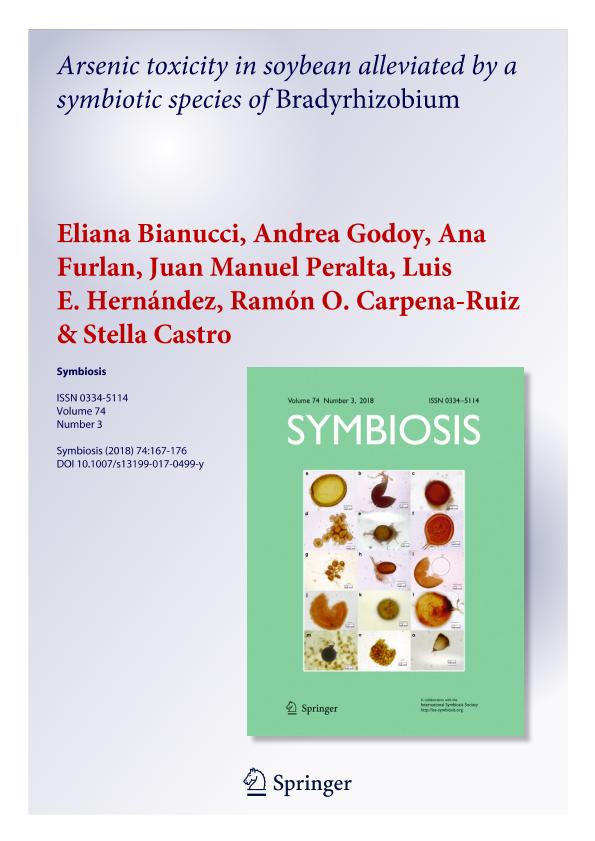Mostrar el registro sencillo del ítem
dc.contributor.author
Bianucci, Eliana Carolina

dc.contributor.author
Godoy, Andrea
dc.contributor.author
Furlan, Ana Laura

dc.contributor.author
Peralta, Juan Manuel

dc.contributor.author
Hernández, Luis E.
dc.contributor.author
Carpena-Ruiz, Ramón O.
dc.contributor.author
Castro, Stella Maris

dc.date.available
2021-07-01T19:45:57Z
dc.date.issued
2018-03
dc.identifier.citation
Bianucci, Eliana Carolina; Godoy, Andrea; Furlan, Ana Laura; Peralta, Juan Manuel; Hernández, Luis E.; et al.; Arsenic toxicity in soybean alleviated by a symbiotic species of Bradyrhizobium; Springer; Symbiosis; 74; 3; 3-2018; 167-176
dc.identifier.issn
0334-5114
dc.identifier.uri
http://hdl.handle.net/11336/135315
dc.description.abstract
Arsenic (As) is a toxic metalloid that has gained special interest in the past years as a global environmental problem. Groundwater in Córdoba province (Argentina) presents high As concentrations which can be absorbed by plants or be used for artificial irrigation. The aim of this research was to elucidate the differential responses of symbiotic interactions established with three bacterial strains and soybean plants to realistic doses of arsenic. The reference strain Bradyrhizobium diazoefficiens USDA110 and the native isolate Bradyrhizobium sp. Per 3.64 were able to grow up to 13 mM As(V) whereas the native strain Bradyrhizobium sp. Per 3.61 grew up to 9.5 mM As(V). Metalloid addition did not modify the soybean plant growth at 6 μM As(V). Nevertheless, it was enough to induce oxidative stress as observed by an increase on lipid peroxidation. The soybean-Bradyrhizobium sp. assay at 6 μM As(V) showed no changes in growth variables (shoot and root dry weight) in plants inoculated with the reference microsymbiont or Bradyrhizobium sp. Per 3.61. Regarding As uptake by plants, metalloid accumulation followed the same distribution pattern among strains. Remarkably, at 6 μM As(V), soybean inoculation with Bradyrhizobium sp. Per 3.61 revealed a significantly lower translocation factor (TF) in comparison to other inoculated strains promoting As phytostabilization. At the highest As(V) concentration tested, only Bradyrhizobium diazoefficiens USDA110 was able to nodulate the legume, however, a significant decrease in the number and dry weight of nodules and nitrogen content was observed. In conclusion, the inoculation of soybean plants with the reference strain Bradyrhizobium diazoefficiens USDA110 exposed to high As(V) concentration represents an effective and promising symbiotic interaction that allows the development of the legume due to the minimal effects on plant growth. However, in low As(V) concentration environments, the native isolate Bradyrhizobium sp. Per 3.61, is shown to be the best inoculant among the tested strains, owing to the limitation of metalloid translocation and accumulation to edible parts of the legume, avoiding fruit contamination and human poisoning.
dc.format
application/pdf
dc.language.iso
eng
dc.publisher
Springer

dc.rights
info:eu-repo/semantics/openAccess
dc.rights.uri
https://creativecommons.org/licenses/by-nc-sa/2.5/ar/
dc.subject
ARSENIC
dc.subject
BRADYRHIZOBIUM SP
dc.subject
LEGUME
dc.subject
SYMBIOTIC INTERACTION
dc.subject.classification
Ciencias del Suelo

dc.subject.classification
Agricultura, Silvicultura y Pesca

dc.subject.classification
CIENCIAS AGRÍCOLAS

dc.title
Arsenic toxicity in soybean alleviated by a symbiotic species of Bradyrhizobium
dc.type
info:eu-repo/semantics/article
dc.type
info:ar-repo/semantics/artículo
dc.type
info:eu-repo/semantics/publishedVersion
dc.date.updated
2021-06-16T15:15:02Z
dc.identifier.eissn
1878-7665
dc.journal.volume
74
dc.journal.number
3
dc.journal.pagination
167-176
dc.journal.pais
Alemania

dc.journal.ciudad
Berlin
dc.description.fil
Fil: Bianucci, Eliana Carolina. Universidad Nacional de Río Cuarto. Facultad de Ciencias Exactas, Fisicoquímicas y Naturales. Departamento de Ciencias Naturales; Argentina. Consejo Nacional de Investigaciones Científicas y Técnicas; Argentina
dc.description.fil
Fil: Godoy, Andrea. Universidad Nacional de Río Cuarto. Facultad de Ciencias Exactas, Fisicoquímicas y Naturales. Departamento de Ciencias Naturales; Argentina
dc.description.fil
Fil: Furlan, Ana Laura. Universidad Nacional de Rio Cuarto. Facultad de Ciencias Exactas Fisicoquímicas y Naturales. Instituto de Investigaciones Agrobiotecnológicas - Consejo Nacional de Investigaciones Científicas y Técnicas. Centro Científico Tecnológico Conicet - Córdoba. Instituto de Investigaciones Agrobiotecnológicas; Argentina
dc.description.fil
Fil: Peralta, Juan Manuel. Universidad Nacional de Río Cuarto. Facultad de Ciencias Exactas, Fisicoquímicas y Naturales. Departamento de Ciencias Naturales; Argentina. Consejo Nacional de Investigaciones Científicas y Técnicas; Argentina
dc.description.fil
Fil: Hernández, Luis E.. Universidad Autónoma de Madrid. Facultad de Ciencias. Departamento de Biología; España
dc.description.fil
Fil: Carpena-Ruiz, Ramón O.. Universidad Autónoma de Madrid; España
dc.description.fil
Fil: Castro, Stella Maris. Universidad Nacional de Río Cuarto. Facultad de Ciencias Exactas, Fisicoquímicas y Naturales. Departamento de Ciencias Naturales; Argentina
dc.journal.title
Symbiosis

dc.relation.alternativeid
info:eu-repo/semantics/altIdentifier/url/http://link.springer.com/10.1007/s13199-017-0499-y
dc.relation.alternativeid
info:eu-repo/semantics/altIdentifier/doi/https://doi.org/10.1007/s13199-017-0499-y
Archivos asociados
